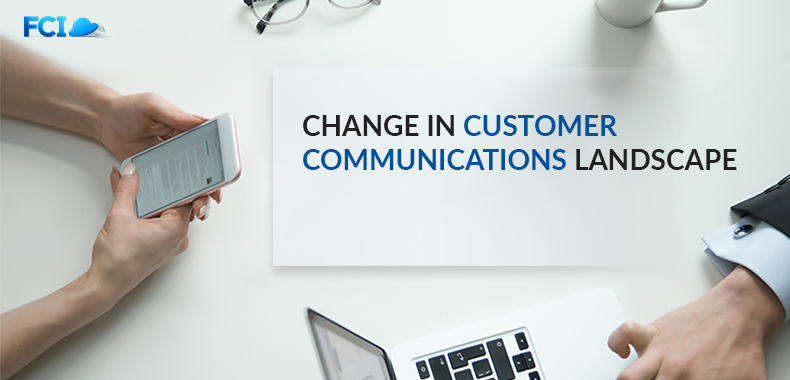In the rapidly evolving realm of business, the landscape of customer communication management is undergoing a remarkable and fundamental transformation. This shift is being propelled by a confluence of factors, including the relentless march of technological advancements, customer communications strategy evolving customer expectations, and the ever-shifting dynamics of the market. As a result, businesses find themselves at a critical juncture where adaptation is no longer optional but rather an imperative for maintaining competitiveness and relevance.
We aim to shed light on the key drivers that are reshaping how companies engage with their clientele. From the adoption of cutting-edge digital tools and platforms to the growing emphasis on personalization and data-driven insights, we explore the forces that are redefining the customer-business relationship. We will also delve into the strategies and tactics that businesses can employ to not only weather this transformative storm but thrive within it.
Amid these changes, there are opportunities to cultivate stronger customer connections, harness the power of data and automation, and foster compliance and trust. Our goal is to provide businesses with the knowledge and insights they need to not only survive but flourish in this new era of customer communications, where adaptability is the key to staying relevant and prosperous.
The Digital Transformation Catalyst: Driving Change in the Modern World
In today’s rapidly evolving business landscape, digital transformation has emerged as a driving force reshaping how companies engage with their customers. This transformation encompasses a variety of technological advancements, innovations, and shifts in consumer behavior. One key facet of this transformation is the rise of digital channels.
A. The Rise of Digital Channels
1. Proliferation of Digital Channels: In recent years, we have witnessed the rapid proliferation of digital channels for customer communication. These channels include but are not limited to social media platforms, mobile apps, and various chat platforms. Each of these channels presents unique opportunities for businesses to connect with their customers in ways that were previously unimaginable.
2. Impact of the COVID-19 Pandemic: The COVID-19 pandemic dramatically accelerated the adoption of digital channels. With lockdowns and social distancing measures in place, people turned to digital platforms for various aspects of their lives, including work, shopping, and entertainment. Businesses had to quickly adapt to meet the increased demand for online services, and many accelerated their digital transformation efforts to remain competitive.
This shift towards digital channels is not a temporary change but a fundamental alteration in how businesses and consumers interact. It emphasizes the need for companies to be present and engaging on the digital platforms that their customers prefer. The rise of these digital channels not only provides a wider reach for businesses but also places a premium on delivering consistent and quality experiences in these digital spaces. Companies that understand this shift are better positioned to meet customer expectations and excel in the modern business landscape.
B. Customer Expectations
1. Customer Expectations have significantly evolved in recent years, driven by advancements in technology and changing market dynamics. In the realm of effective customer communications strategy, customers now have higher expectations than ever before. Here’s a breakdown of these evolving expectations:
2. Seamless Interactions: Customers today expect interactions with businesses to be seamless. This means they desire a frictionless experience when engaging with a company, whether it’s for inquiries, transactions, or support. They want to be able to switch between different communication channels (e.g., website, mobile app, chat, phone) without any disruption or loss of context.
3. Real-Time Communication: Customers want immediate responses and solutions to their inquiries. They no longer have the patience for delayed or asynchronous communication. They expect businesses to be available 24/7 and respond promptly, especially through channels like live chat, instant messaging, or social media.
4. Personalized Experiences: Customers want to feel like they are not just a faceless entity but that the company knows and understands their individual needs and preferences. Personalization can include addressing customers by their name, recommending products or services based on their past behavior, and tailoring content and offers to their specific interests.
5. Unified Customer Experience: Your customers don’t want to feel like they are dealing with different silos within the same company when they switch from, say, a website to a mobile app or from a chat conversation to a phone call. They expect a consistent and coherent experience. This means that customer information, history, and preferences should be readily available to all customer service representatives, regardless of the channel through which the customer initiates contact.
Harnessing Data-Driven Customer Insights for Exceptional Personalization
A. Data-Driven Insights
In the modern business landscape, the ability to gain data-driven insights has become crucial in understanding and effectively communicating with customers. This section focuses on the role of innovative customer communications strategy in delivering compliant and data-driven communications.
1. The role of CCM in delivering communication with compliance:
In an era marked by stringent regulations and privacy concerns, businesses must ensure that their communications meet compliance standards. CCM plays a pivotal role in this aspect by providing a framework that allows businesses to create and distribute communications while adhering to relevant regulations. This includes data privacy laws, industry-specific compliance requirements, and more. Whether it’s sending financial statements, healthcare records, or marketing messages, CCM ensures that all communications are in line with legal and industry standards. This not only minimizes the risk of legal repercussions but also builds trust with customers who value their data privacy and the security of their information.
2. Leveraging customer analytics to craft more targeted and relevant communications:
In summary, this section underscores the importance of data-driven insights in the context of CCM. It explains how CCM aids businesses in staying compliant with regulations while harnessing the power of customer analytics to create more personalized, targeted, and relevant communications. This data-driven approach not only enhances the customer experience but also drives better results in terms of customer engagement and satisfaction.
B. Personalization
In the evolving landscape of customer communications strategy, personalization has emerged as a cornerstone of success. It involves tailoring messages, content, and interactions to the specific preferences and needs of individual customer segments. This approach recognizes that customers are not monolithic; they have unique tastes, behaviors, and expectations. Personalization aims to create a more engaging and relevant experience for each customer.
The Significance of Personalization:
1. Enhanced Customer Engagement: Personalization is a powerful tool for engaging customers. When individuals receive content and offers that resonate with their interests and past interactions, they are more likely to pay attention and respond. This results in higher engagement rates and increased customer satisfaction.
2. Improved Conversion Rates: By understanding customer behavior and preferences, businesses can tailor their communications to drive desired actions, such as making a purchase, signing up for a service, or providing feedback. This results in improved conversion rates and a higher return on investment (ROI).
3. Customer Loyalty: Personalization creates a sense of value and connection. When customers feel that a brand understands them and caters to their needs, they are more likely to remain loyal over time. This helps in building long-term customer relationships and reducing churn.
4. Competitive Advantage: In a crowded marketplace, personalization sets businesses apart from their competitors. Companies that excel at personalization are more likely to attract and retain customers, leading to a sustainable competitive advantage.
Transforming Industries with Automation and AI Innovations
A. Chatbots and Virtual Assistants
In recent years, there has been a significant increase in the adoption of chatbots and virtual assistants by businesses as an integral part of their customer communications strategy. These AI-driven tools have transformed customer support and engagement in the following ways:
The rise of chatbots and virtual assistants in providing instant customer support:
Chatbots and virtual assistants are AI-powered applications that can interact with customers in real time, providing quick responses to queries and issues. They are available 24/7, offering round-the-clock support, which is especially beneficial for global businesses with customers in different time zones.
Streamlining routine inquiries and improving efficiency:
Chatbots excel at handling routine and frequently asked questions. They can quickly address common issues, freeing up human agents to focus on more complex and value-added tasks. Automation through chatbots not only reduces response times but also ensures consistency in customer interactions.
B. Predictive Analytics
AI-driven predictive analytics is another game-changer in the customer communications strategy. It empowers businesses to take a proactive approach to customer interactions, enhancing satisfaction and loyalty:
How AI can predict customer needs and offer proactive solutions:
Predictive analytics leverages machine learning algorithms to analyze customer data, identify patterns, and anticipate customer needs. For example, AI can predict when a customer might need to reorder a product, schedule a maintenance visit, or renew a subscription, allowing businesses to offer solutions before customers even realize they have a need.
The potential to reduce churn and boost customer satisfaction:
By proactively addressing customer needs and issues, businesses can significantly reduce churn rates, and retain valuable customers. Predictive analytics also contributes to improved customer satisfaction, as customers appreciate proactive service that meets their needs and preferences.
In summary, automation and AI, particularly through chatbots, virtual assistants, and predictive analytics, are revolutionizing customer communications strategy. They provide instant support, streamline routine tasks, and enable businesses to anticipate and meet customer needs more effectively.
Omnichannel Excellence: A Winning Customer Communications Strategy
In today’s dynamic business landscape, the concept of an omnichannel strategy has gained paramount importance. An omnichannel strategy is centered around providing customers with a seamless and unified experience across various communication channels, whether it be in-store, online, through mobile apps, or on social media. Here’s why creating cohesive customer journeys is so crucial:
1. Seamless Experience: Customers interact with businesses through a multitude of touchpoints. These interactions should seamlessly transition between different channels, allowing customers to start a conversation on one platform and continue it on another without any disruption. This seamlessness greatly enhances the customer experience.
2. Consistency in Messaging: One of the keys to successful omnichannel communication is maintaining consistency in the messages conveyed. Regardless of the channel, customers should receive consistent and coherent messages. This consistency reinforces your brand’s identity and messaging, making it more recognizable and trustworthy.
3. Consistency in Branding: Alongside messaging, the look and feel of your brand, including its visual elements, should remain consistent across channels. Consistency in branding helps customers quickly recognize and trust your business, fostering a sense of familiarity.
4. User Experience: User experience (UX) plays a pivotal role in the success of an omnichannel strategy. Ensuring that the user experience is as smooth, user-friendly, and intuitive as possible across all channels is essential. A positive UX encourages customers to engage more and stay loyal to your brand.
Businesses have successfully leveraged an omnichannel strategy to enhance customer retention and revenue. Customers appreciate the convenience, consistency, and personalization provided through these channels, which ultimately leads to stronger customer relationships and increased profitability.
Compliance and Security: Safeguarding Your Business Values
A. Regulatory Challenges
Navigating the complex landscape of data privacy and security regulations:
In an increasingly data-centric world, businesses are faced with a multitude of data privacy and security regulations and laws. This includes well-known regulations like GDPR in Europe, CCPA in California, HIPAA in healthcare, and numerous industry-specific standards. Complying with these regulations is essential to protect customers’ sensitive information and maintain the trust of both customers and regulatory bodies. Navigating this regulatory landscape involves staying up-to-date with evolving laws, understanding how they apply to your business, and implementing the necessary measures to ensure compliance.
The consequences of non-compliance:
Failing to adhere to data privacy and security regulations can have severe consequences for businesses. These consequences may include hefty fines, legal actions, reputational damage, and a loss of customer trust. Non-compliance can be a significant financial and operational risk, making it imperative for businesses to invest in robust compliance measures.
B. Building Trust
How businesses can use compliance as a competitive advantage:
Compliance with data privacy and security regulations is not just about avoiding penalties; it can also be leveraged as a competitive advantage. By demonstrating a commitment to safeguarding customer data, businesses can gain the trust of their customers. They can use compliance as a selling point, reassuring customers that their personal information is treated with the utmost care. This can be a significant differentiator in industries where trust is paramount, such as healthcare, finance, and e-commerce.
The role of transparent and secure customer communications strategy in fostering trust:
Transparent and secure customer communications strategy play a pivotal role in building and maintaining trust. When customers receive clear and concise information about how their data is handled, stored, and protected, it creates a sense of security. Transparent communications also involve informing customers about their rights, including opting out of data collection and being forgotten (as per GDPR). Additionally, providing secure channels for customer interactions, such as encrypted email or messaging services, assures customers that their sensitive information is well-protected.
Compliance with data privacy and security regulations is not just a legal obligation; it’s a strategic asset for businesses. It can be used to gain a competitive edge by building trust with customers, who, in today’s digital age, are increasingly concerned about the safety and privacy of their personal data. Transparent and secure customer communications strategy are essential components of this trust-building process, ensuring that customers feel safe and valued by the businesses they interact with.
Navigating the Modern Landscape: Customer Communications Strategy
As the paradigm of customer communications strategy continues to evolve, businesses that embrace this change will thrive in the modern landscape. The fusion of digital transformation, data analytics, automation, and an omnichannel approach is the recipe for success. It’s imperative for businesses to focus on delivering value while maintaining compliance and security to ensure a bright future in this new era of customer communications.
Ultimately, those who understand and adapt to these shifts will forge stronger customer relationships, increase brand loyalty, and secure a competitive edge in the marketplace. The time to embrace the paradigm change in the customer communications landscape is now.





























 Banking
Banking
 Insurance
Insurance
 Credit Unions
Credit Unions








 Professional Services
Professional Services
 Consulting & Advisory
Consulting & Advisory
 Legacy Migration
Legacy Migration


 Insights
Insights
 Whitepapers
Whitepapers
 FAQs
FAQs
 Brochures
Brochures
 E-Books
E-Books
 Glossary
Glossary 
 Case Studies
Case Studies
 Events & News
Events & News
 About Us
About Us
 Information Security
Information Security
 FCI Cares
FCI Cares
 Leadership
Leadership
 Careers
Careers
 Partner Program
Partner Program
 Current Openings
Current Openings



